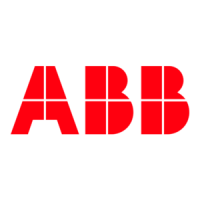Chapter 2 – AC 80 Hardware and Connections
AC 80 User’s Manual 2-19
Special I/O Connection
This DDCS-protocol fibre optic link (Channel 1 on the NCB board) can
be used for connecting up to eight I/O devices to the AC 80. The
devices are addressed 1 to 8, and connected in a ring.
The transmission speed of the Special I/O connection is 4 Mbit/s.
The Special I/O connection can be used with the following devices:
• NBIO-21 (Basic I/O Unit 2), an I/O module with 2 analogue
inputs, 2 analogue outputs, 3 digital inputs and 2 digital outputs.
(One digital input and one digital output are dedicated for the
emergency stop function.)
• NBIO-31 (Basic I/O Unit 3), an I/O module with 4 digital inputs
and 3 digital outputs. (One input and one output are dedicated
for the emergency stop function.)
• NPCT-01 (Pulse Counter and Timer Unit), an I/O module with
two incremental encoder inputs, 4 digital inputs and 4 digital
outputs.
• NDSC-01, the control board of a Diode Supply Unit (DSU).
Fieldbus Adapter
Connection
This DDCS-protocol, 4 Mbit/s fibre optic link (Channel 2 on the NCB
board) can be used for connecting the AC 80 to a fieldbus such as
PROFIBUS-DP. A fieldbus adapter module acts as an interface
between the fibre optic link and the serial bus.
Tool Connection
This DDCS-protocol fibre optic link (Channel 3 on the NCB board) can
be used for connecting the AC 80 to a PC with e.g. Drive
Debug.
The PC must be equipped with a PCMCIA/DDCS (laptop) or an
ISA/DDCS (desktop) interface.
The transmission speed used is 1 Mbit/s.

